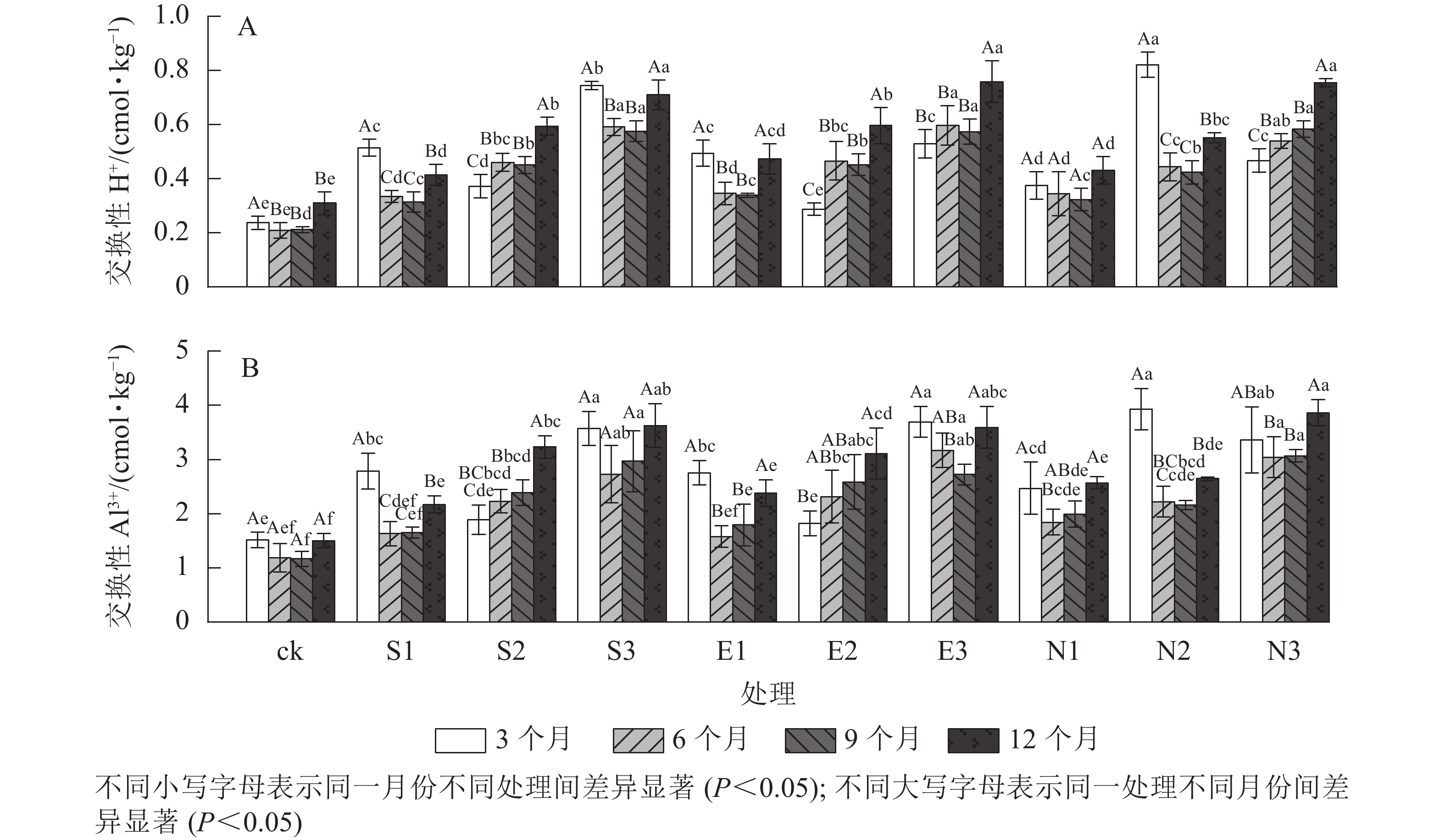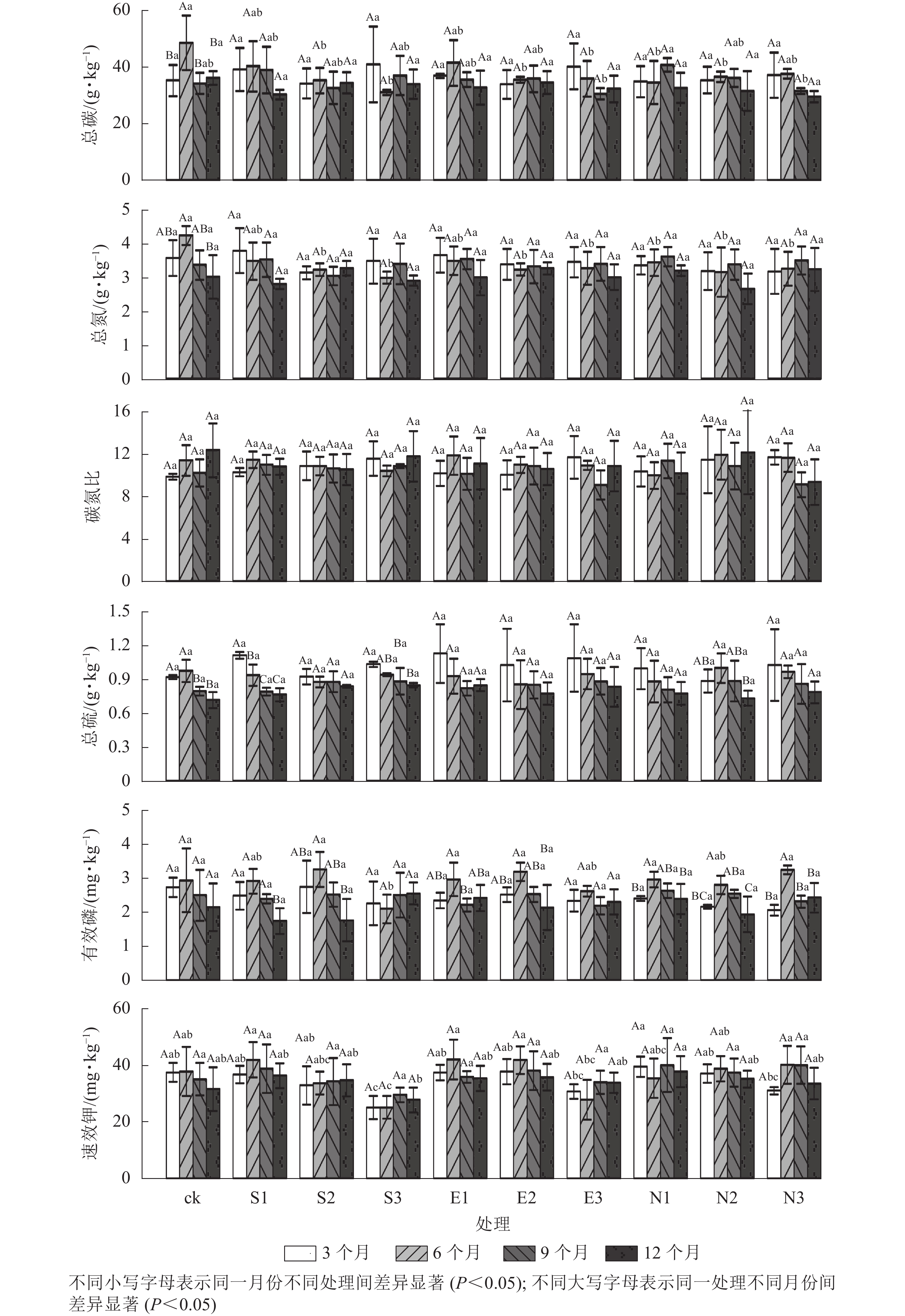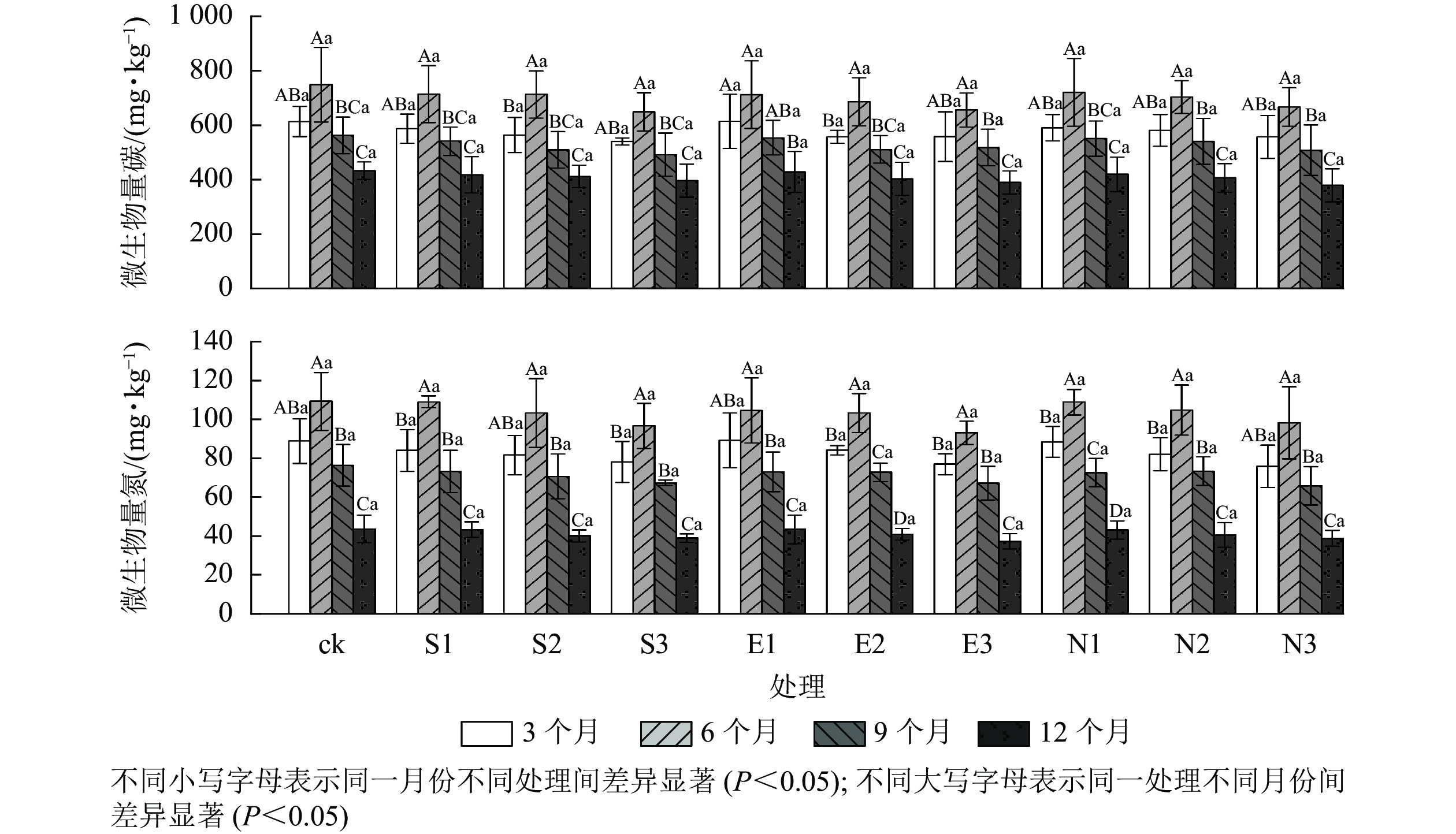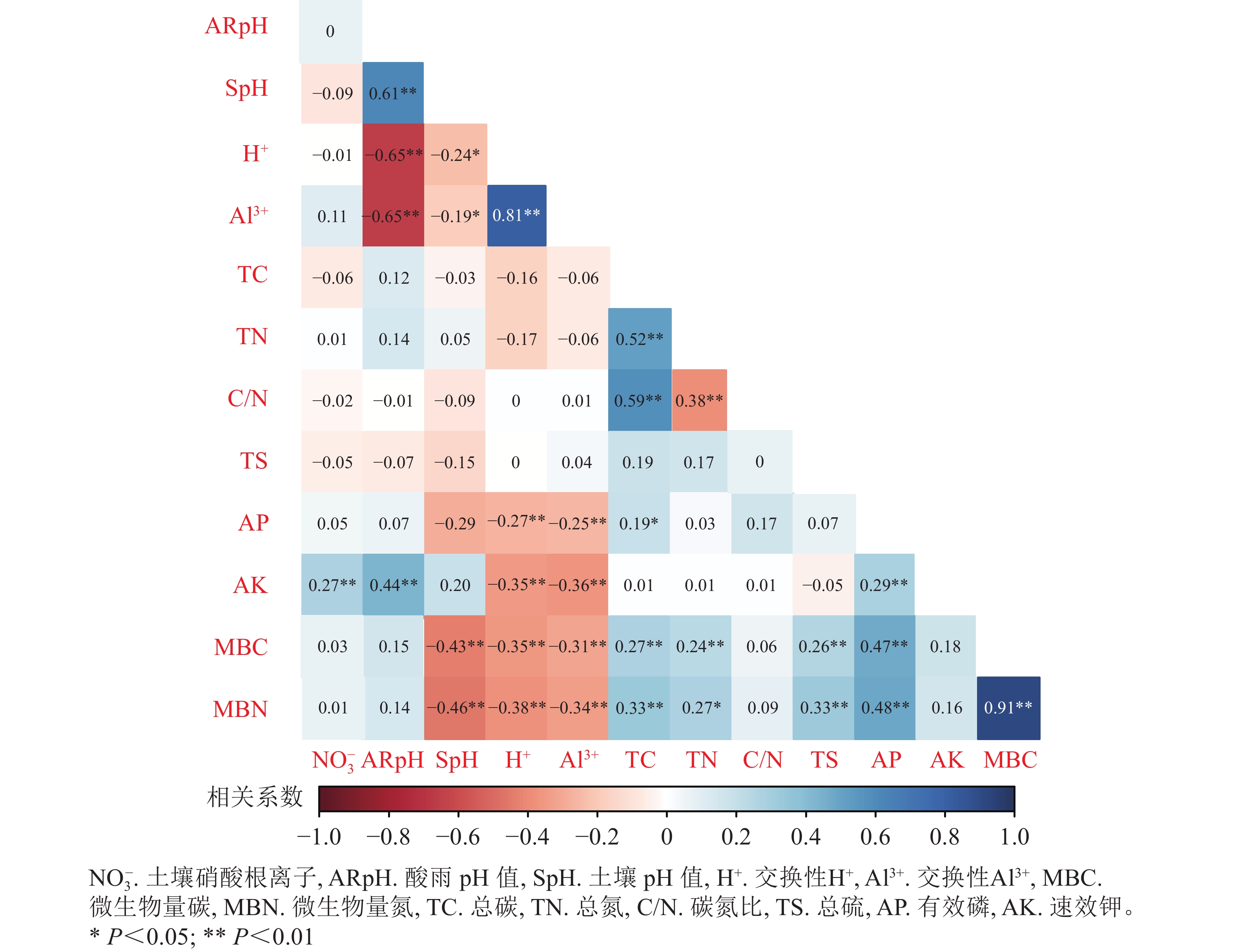-
杉木Cunninghamia lanceolata是中国特有的优良速生针叶树种,也是中国亚热带地区的主要造林树种,占全国人工林面积的17.33%[1]。由于片面追求速生丰产,杉木人工林出现了生产力下降、地力衰退等问题;而且杉木林树种单一,结构不稳定,生物多样性相对较低[2],导致其应对全球变化的能力不足。酸雨是全球变化的主要表现形式之一,而中国已经是欧洲、北美后的世界第三大酸雨区。近年来,长江三角洲地区已经开始控制二氧化硫(SO2)的排放,但汽车数量的激增引起更高的氮氧化物(NOx)排放量,导致硝酸盐(NO3 −)沉淀增加[3]。2003—2010年,酸雨中硫酸根(SO4 2−)与硝酸根(NO3 −)比值从7.5降到2.0[4],预计未来会继续下降。可见,酸雨类型正逐渐由硫酸雨(SAR)转变为硝酸雨(NAR),这将对该区域生态系统带来新的威胁,尤其是遭受酸雨危害严重的中国南方地区。
杉木林土壤是生态系统中受酸沉降影响最大的部分,其中酸雨会直接改变土壤pH[5],影响土壤化学性质[6]。酸雨输入增加土壤氢离子(H+)负荷[7],并与交换络合物上的钙离子(Ca2+)、镁离子(Mg2+)或钾离子(K+)进行交换,但这些离子难以被植物吸收。此外,一些有毒重金属离子,如铝离子(Al3+)、铅离子(Pb2+)、汞离子(Hg2+)、镉离子(Cd+)等也被H+取代[8],对植物产生毒害作用。总碳、总氮、总硫、有效磷和速效钾等同样受到土壤酸化影响,造成土壤养分流失[9],引起杉木林地力衰退。土壤微生物在参与土壤养分循环和维持生态系统平衡中发挥重要作用[10],是土壤活性碳氮库的重要成分[11],也是生态系统碳氮转化进程的生物指标,可以用微生物量碳氮表示[12]。前期研究发现:土壤pH也对微生物量碳氮变化具有重要影响[13]。
酸雨胁迫是影响杉木林地力衰退的主要环境因子之一,然而关于酸雨类型转变对杉木林土壤养分流失及微生物响应机制研究相对较少,而且研究对象集中在马尾松Pinus massoniana及阔叶林[14]。因此,本研究以南方杉木人工林为研究对象,探究酸雨类型转变对杉木林土壤养分及微生物特征的影响,以期为南方酸雨胁迫地区杉木人工林可持续发展提供理论基础。
-
研究区位于南京市20 km外的国有东善桥林场铜山分场(31°37′N,118°51′E)。该区年平均降水量为1 117.2 mm,年均气温为15.1 ℃,无霜期为229.0 d,年日照时数为2 199.5 h。地形以丘陵为主,海拔为38~388 m,属北亚热带季风气候区,气候温和湿润,土壤类型以黄棕壤为主。森林类型以毛竹Phyllostachys edulis、杉木、麻栎Quercus aeutissima和马尾松等为主。本研究以杉木人工纯林为研究对象,该林分海拔为311 m,坡度为22°,西北坡向,林分密度为850株·hm−2,郁闭度为0.61,平均树高、胸径、冠幅分别为10.8 m、13.2 cm和2.4 m。
-
随机在杉木林的上、中、下坡选定长2 m,宽60 cm的样地,在树干下1 m处采样,共计120个采样点,每月进行2次酸溶液喷施,并采集样方表层0~10 cm土壤,用于土壤各项指标测定。
-
利用0.5 mol·L−1硫酸(H2SO4)与0.5 mol·L−1硝酸(HNO3)配制3种酸雨类型(SO4 2−/NO3 −的体积比分别为5∶1、1∶1和1∶5)和3种酸度(pH 4.5、pH 3.5、pH 2.5)的酸雨溶液,分别为硫酸型酸雨(S1:SO4 2−/NO3 −的体积比为5∶1,pH 4.5;S2:SO4 2−/NO3 −的体积比为5∶1,pH 3.5;S3:SO4 2−/NO3 −的体积比为5∶1,pH 2.5)、混合型酸雨(E1:SO4 2−/NO3 −的体积比为1∶1,pH 4.5;E2:SO4 2−/NO3 −的体积比为1∶1,pH 3.5;E3:SO4 2−/NO3 −的体积比为1∶1,pH 2.5)和硝酸型酸雨(N1:SO4 2−/NO3 −的体积比为1∶5,pH 4.5;N2:SO4 2−/NO3 −的体积比为1∶5,pH 3.5;N3:SO4 2−/NO3 −的体积比为1∶5,pH 2.5),同时设置对照处理(ck,山间防火池水,pH 6.6),共10个处理组。根据南京地区全年月平均降水量,分配每月喷施模拟酸雨量,模拟酸雨量占南京月均降水量的2/3,约占全年降水量的5.55%。每月月初和月中使用花洒各喷施1次[15],共计4个季度:春季(3—5月),喷施酸雨总量为12.79 mm,比例为20.62%;夏季(6—8月),喷施酸雨总量为32.35 mm,比例为52.11%;秋季(9—11月),喷施酸雨总量为9.35 mm,比例为15.08%;冬季(12月至翌年2月),喷施酸雨总量为7.57 mm,比例为12.19%。
-
采用电位法测定土壤pH;氟化氨-盐酸浸提法测定土壤有效磷(AP);乙酸铵-火焰光度法测定土壤速效钾(AK);元素分析仪测定土壤碳(TC)、氮(TN)、硫(TS)[16];使用1 mol·L−1氯化钾交换-中和滴定法测定土壤交换性H+、Al3+[17];使用氯仿熏蒸浸提法测定土壤微生物量碳氮质量分数。
-
各类型酸雨处理对土壤化学性质和微生物量碳氮的影响用单因素方差分析,酸雨pH与硝酸根离子对各因素的影响,采用双因素方差分析。利用R语言(V3.5.1)分析酸雨胁迫下各因素之间的相关性。结构平衡方程(structural equation model,SEM)来解释酸雨pH与硝酸根离子对土壤微生物量碳氮的直接和间接影响。
-
由表1可见:3种类型酸雨胁迫下,随着酸雨酸度增加,土壤pH呈显著下降趋势,且受胁迫时间的影响显著(P<0.001),但酸雨类型对土壤pH影响不显著。由图1可见:施加酸雨6个月后各处理土壤的pH显著低于其他时间(P<0.05)。与ck相比,3和12个月酸雨处理均显著降低了土壤pH (P<0.05)。
影响因子 3个月 6个月 9个月 12个月 酸雨类型 0.403 0.672 0.220 0.703 酸雨酸度 <0.001*** <0.001*** <0.001*** 0.006** 酸雨类型×酸雨酸度 0.992 0.981 0.657 0.966 时间 <0.001*** 酸雨类型×酸雨酸度×时间 0.999 说明:数值为显著性P值。**P<0.01;***P<0.001 Table 1. P values of soil pH under different acid rain types and acid rain stress
-
由图2和表2可见:随着酸雨酸度的增加,土壤交换性H+、Al3+质量摩尔浓度均呈显著上升趋势,且胁迫时间差异显著(P<0.001)。施加酸雨3个月后,酸雨类型显著影响交换性H+(P<0.001)和交换性Al3+(P<0.05)。施加酸雨9和12个月后,S1、S3处理土壤交换性H+和Al3+质量摩尔浓度均小于N1、N3处理;与对照相比,酸雨pH为2.5时,S3、E3和N3处理的土壤交换性H+质量摩尔浓度均值分别增长了275%、254%和246%,交换性Al3+质量摩尔浓度均值分别增长了240%、246%和249%。
影响因子 土壤指标 3个月 6个月 9个月 12个月 酸雨类型 <0.001*** 0.534 0.787 0.278 酸雨酸度 <0.001*** <0.001*** <0.001*** <0.001*** 酸雨类型×酸雨酸度 交换性H+ <0.001*** 0.855 0.816 0.605 时间 <0.001*** 酸雨类型×酸雨酸度×时间 <0.001*** 酸雨类型 0.013* 0.496 0.902 0.990 酸雨酸度 <0.001*** <0.001*** <0.001*** <0.001*** 酸雨类型×酸雨酸度 交换性Al3+ <0.001*** 0.669 0.227 0.052 时间 <0.001*** 酸雨类型×酸雨酸度×时间 <0.001*** 酸雨类型 0.805 0.721 0.531 0.635 酸雨酸度 0.371 0.306 0.070 0.710 酸雨类型×酸雨酸度 总碳 0.961 0.379 0.320 0.782 时间 0.018* 酸雨类型×酸雨酸度×时间 0.688 酸雨类型 0.517 0.896 0.704 0.861 酸雨酸度 0.333 0.315 0.344 0.924 酸雨类型×酸雨酸度 总氮 0.942 0.957 0.975 0.118 时间 0.009** 酸雨类型×酸雨酸度×时间 0.862 酸雨类型 0.783 0.840 0.496 0.907 酸雨酸度 0.232 0.900 0.190 0.904 酸雨类型×酸雨酸度 碳氮比 0.951 0.249 0.592 0.598 时间 0.513 酸雨类型×酸雨酸度×时间 0.816 酸雨类型 0.550 0.880 0.990 0.382 酸雨酸度 0.395 0.770 0.409 0.640 酸雨类型×酸雨酸度 总硫 0.986 0.708 0.987 0.675 时间 <0.001*** 酸雨类型×酸雨酸度×时间 0.995 酸雨类型 0.315 0.340 0.379 0.447 酸雨酸度 0.379 0.049* 0.430 0.121 酸雨类型×酸雨酸度 有效磷 0.768 0.012* 0.648 0.482 时间 <0.001*** 酸雨类型×酸雨酸度×时间 0.159 酸雨类型 0.058 0.246 0.274 0.481 酸雨酸度 <0.001*** 0.012* 0.492 0.104 酸雨类型×酸雨酸度 速效钾 0.809 0.029* 0.651 0.707 时间 0.276 酸雨类型×酸雨酸度×时间 0.534 酸雨类型 0.900 0.959 0.842 0.971 酸雨酸度 0.334 0.383 0.449 0.497 酸雨类型×酸雨酸度 土壤微生物量碳 0.977 0.998 0.989 0.997 时间 <0.001*** 酸雨类型×酸雨酸度×时间 1.000 酸雨类型 0.886 0.820 0.990 0.993 酸雨酸度 0.101 0.171 0.274 0.100 酸雨类型×酸雨酸度 土壤微生物量氮 0.972 0.998 0.994 0.990 时间 <0.001*** 酸雨类型×酸雨酸度×时间 1.000 说明:数值为显著性P值。*P<0.05;**P<0.01;***P<0.001 Table 2. P values of soil acidity index under different acid rain types and acid rain stress
-
由图3和表2可见:随着酸雨酸度的增加,土壤总碳、总氮、总硫和有效磷质量分数存在显著的时间差异(P<0.05)。施加酸雨3和6个月后,酸雨酸度显著影响速效钾质量分数,6个月后,酸雨酸度显著影响有效磷质量分数,且酸雨酸度与酸雨类型对有效磷和速效钾的交互效应显著(P<0.05)。施加酸雨6个月后,N1处理的土壤总碳质量分数显著低于S1和ck (P<0.05)。9个月后,N1处理的土壤总碳质量分数显著高于S1和ck (P<0.05)。S3处理的有效磷质量分数显著低于ck和N3 (P<0.05)。在3、6、9和12个月,S3处理的速效钾质量分数均最低,分别为(25.03±4.17)、(25.09±3.97)、(29.47±2.57)和(27.69±4.44) mg·kg−1。
-
由图4和表2可见:随着酸雨酸度的增加,土壤微生物量碳氮呈显著下降趋势,且胁迫时间差异显著(P<0.05)。施加酸雨6个月后,对照处理组的土壤微生物量碳氮最高,分别为(748.64±136.66)和(109.28±14.88) mg·kg−1。与对照相比,S3、E3和N3处理均显著降低了土壤微生物量碳氮,其中,胁迫12月后N3处理的微生物量碳和微生物量氮质量分数达到最低值,分别为(378.89±60.69)和(38.67±4.10) mg·kg−1。
-
由图5可见:酸雨pH与土壤pH、速效钾呈显著正相关(P<0.05);总碳与碳氮比、有效磷与微生物量碳氮、微生物量碳与微生物量氮之间均表现出显著的正相关(P<0.05)。而酸雨pH与交换性H+、Al3+表现出显著的负相关(P<0.05);交换性H+、Al3+与速效钾、微生物量碳、微生物量氮之间呈显著负相关(P<0.05)。
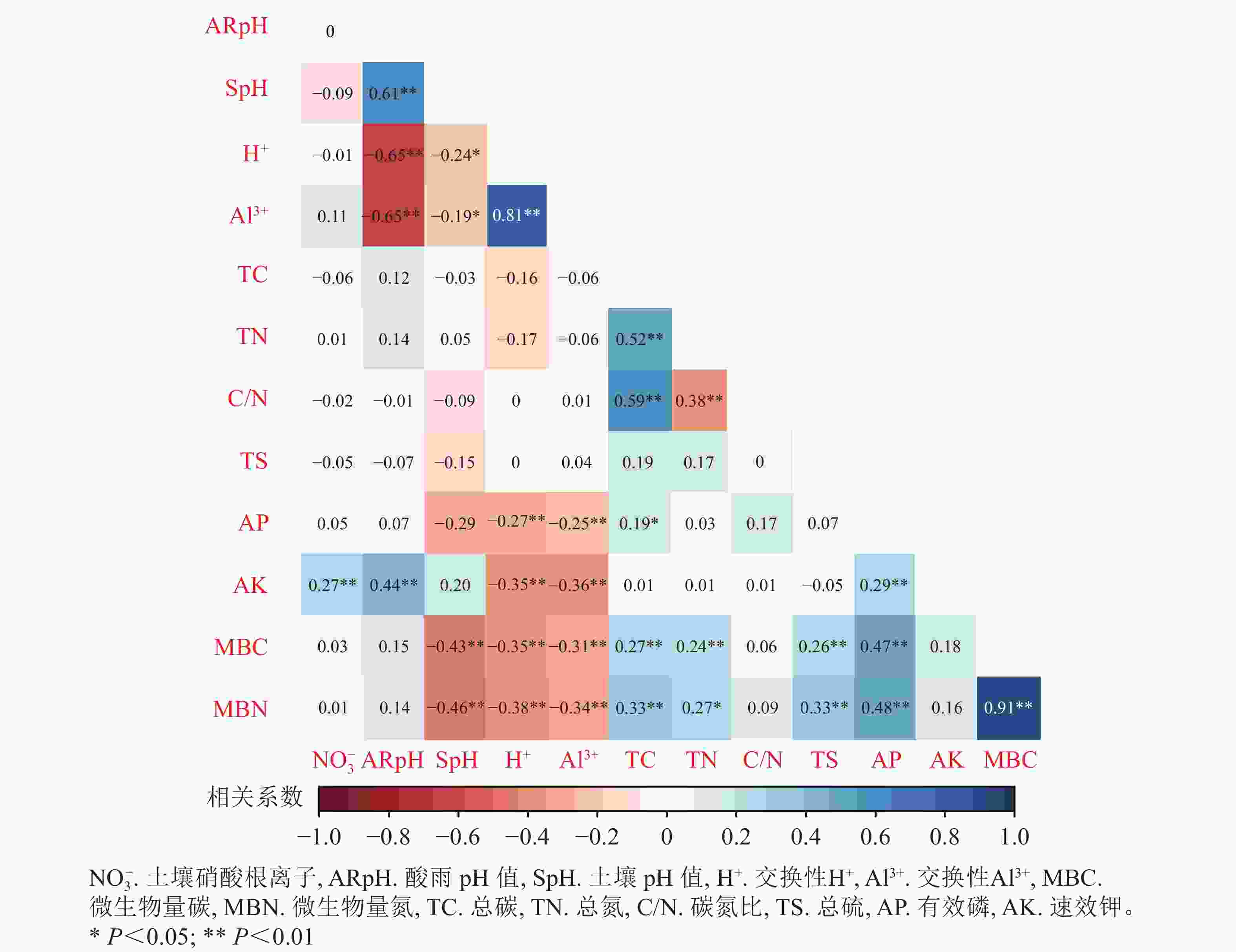
Figure 5. Correlation analysis of soil chemical properties and microbial carbon and nitrogen under acid rain stress
结构方程模型(SEM)通过AMOS软件构建。该模型卡方检验P为0.336(>0.050),近似误差均方根为0.029,拟合优度指数为0.994,参数均符合建模要求(图6)。与相关性分析结果一致,酸雨酸度对微生物量碳的直接影响要高于酸雨类型。酸雨酸度对微生物量碳和微生物量氮的间接影响系数分别为−0.412、0.025,综合影响系数分别为0.154、0.141;酸雨类型对微生物量碳和微生物量氮的间接影响系数分别为0.065和0.032,综合影响系数分别为0.025、0.009 (表3)。另外,从图6可以看出:酸雨酸度主要通过土壤pH、总碳和有效磷间接影响微生物量碳氮,而酸雨类型主要通过土壤pH、总碳和有效磷间接影响微生物量碳氮,酸雨酸度又主要通过土壤pH影响总碳和有效磷而间接影响微生物量碳氮。

Figure 6. SEM analysis of the effects of different acid rain types and acid rain stress on microbial carbon and nitrogen
自变量 酸雨
pH值土壤酸
根离子土壤
pH有效磷 总碳 微生物
量碳总效应 微生物量碳 0.154 0.025 −0.855 0.204 0.139 间接效应 −0.412 0.065 −0.132 总效应 微生物量氮 0.141 0.009 −0.879 0.201 0.200 0.776 间接效应 0.025 0.032 −0.702 0.158 0.108 Table 3. Correlation of parameters and microbial carbon and nitrogen
-
土壤作为森林生态系统的最终受体,对酸雨具有较强的敏感性[9]。酸雨导致土壤pH和盐基饱和度下降,溶出土壤中交换性H+、Al3+,加剧土壤酸化[18],这与本研究结果一致。表明交换性阳离子充当土壤中重要的缓冲剂作用,当土壤pH为4.2~3.8时,已经降到土壤阳离子缓冲范围内[19],土壤中矿物成分释放出充足的交换性Al3+缓冲酸沉降。本研究中,随着酸雨酸度的增加,有效磷质量分数在施加酸雨6个月后显著变化,速效钾质量分数在3和6个月后均有显著变化,同时施加酸雨6个月后,酸雨类型和酸度对有效磷和速效钾交互效应显著。这可能是因为夏季植物生长迅速,杉木林土壤表层的凋落物较少,对酸雨缓冲作用减弱,夏季雨水相比其他季节多,淋溶作用增加,进而导致土壤有效磷和速效钾的流失。然而,酸雨对土壤总碳、总氮、总硫的影响不显著[16]。表明短期的酸雨胁迫不会导致碳、氮、硫的变化,土壤养分的流失需要长时间的积累。
土壤微生物在维持全球生态系统中充当重要角色[6],土壤pH、植被类型、土壤养分、气候条件等的变化直接或间接影响土壤微生物量碳氮的活性[20]。研究发现:微生物对土壤pH有最适宜的区间,过低的土壤pH对微生物活性起到抑制作用[21-22]。本研究在模拟酸雨持续胁迫下,土壤pH呈显著下降,土壤微生物量碳氮在强酸(pH 2.5)处理下显著下降。由于土壤对酸雨的缓冲作用,pH 4.5和pH 3.5对土壤微生物量碳氮没有显著影响,随着酸度的增加及实验周期的延长,各类型酸雨处理对微生物量碳氮的影响显著,这可能是真菌和细菌对强酸更加敏感[23],也可以说明酸雨对土壤微生物量碳氮的影响是一个循序渐进的过程。有研究表明:酸雨胁迫下土壤持续酸化与土壤微生物量碳氮活性的抑制作用有关,H+的毒害作用导致土壤分解者的微生物种类、生物活性和结构均随之发生变化[24]。
土壤微生物量碳氮随着酸雨时间的递增,发生着动态、复杂的变化过程,这也是森林生态系统的研究重点[25]。本研究的土壤微生物存在着显著的月份差异,6—8月土壤微生物量碳氮质量分数最高,12月至翌年2月出现最低值。这可能是因为春季气温回升后,春坝作用[26]使得植物生长恢复,6月土壤微生物活性增强,7—8月达到高峰。而后因为植物和微生物生长对养分的大量需求产生养分物质的竞争[27],导致微生物量碳氮降低。而冬季因为天气寒冷潮湿,使得真菌和细菌数量减少,土壤呼吸作用减弱,导致微生物量碳氮质量分数达到最低值。由于秋冬季大量凋落物掉落,为春季微生物提供较多的代谢物而使得春季微生物量碳氮质量分数相比冬季而言有较大的提升。
酸雨类型变化不仅对土壤养分影响显著,也对土壤微生物影响显著。混合型和硝酸型酸雨减缓了土壤碳氮和磷的矿化,降低了土壤微生物量[28]。本研究中,不同酸雨类型之间对杉木林影响并没有显著区分,NO3 −与SO4 2−没有显著的区别。这可能与试验时间有关,因本研究时间仅1 a,周期较短,导致NO3 −对杉木林影响没有显著表现出来。早期研究发现:硝酸雨对土壤pH和微生物活性的抑制作用比硫酸雨大[15],硝酸雨减缓了土壤碳、氮、磷的矿化作用[29]。
-
1 a的短期酸雨胁迫后,土壤pH随着酸雨酸度的增加而显著降低,硝酸根对土壤pH影响大于硫酸根。酸雨对土壤有效磷和速效钾质量分数影响显著,对土壤总碳、总氮和总硫质量分数影响较小。酸雨酸度和酸雨类型均对微生物量碳氮质量分数影响显著,酸雨酸度对微生物碳氮的影响一方面直接影响,另一方面通过对土壤化学性质的间接影响完成。酸雨类型的转变加剧了酸雨酸度对杉木林土壤特性的抑制作用。
Effects of acid rain type change on soil nutrient characteristics and microbial C and N in the Cunninghamia lanceolata plantation
doi: 10.11833/j.issn.2095-0756.20220132
- Received Date: 2022-01-18
- Accepted Date: 2022-06-06
- Rev Recd Date: 2022-05-11
- Available Online: 2022-11-21
- Publish Date: 2022-12-20
-
Key words:
- simulated acid rain /
- soil pH value /
- soil acidity index /
- soil chemical properties /
- microbial C and N /
- Cunninghamia lanceolata plantation
Abstract:
| Citation: | CHEN Meiling, LIU Xin, CHEN Xinfeng, et al. Effects of acid rain type change on soil nutrient characteristics and microbial C and N in the Cunninghamia lanceolata plantation[J]. Journal of Zhejiang A&F University, 2022, 39(6): 1278-1288. DOI: 10.11833/j.issn.2095-0756.20220132 |




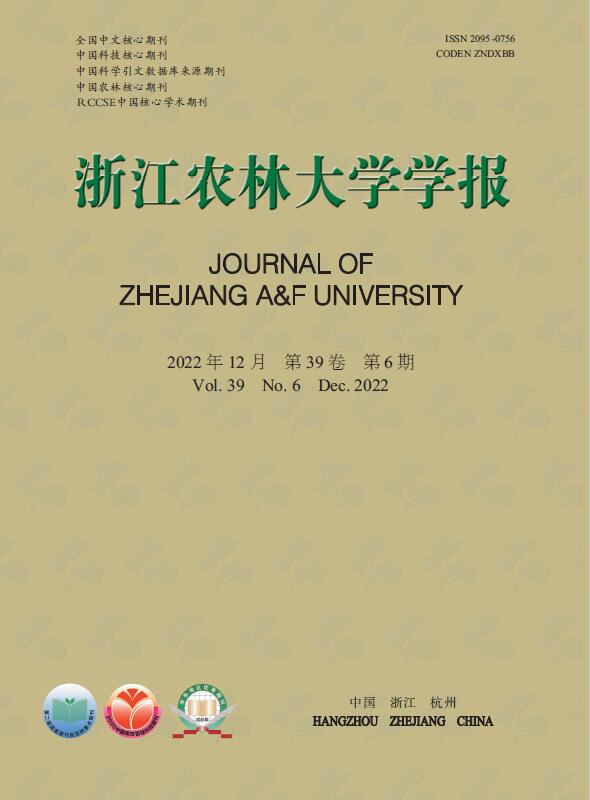





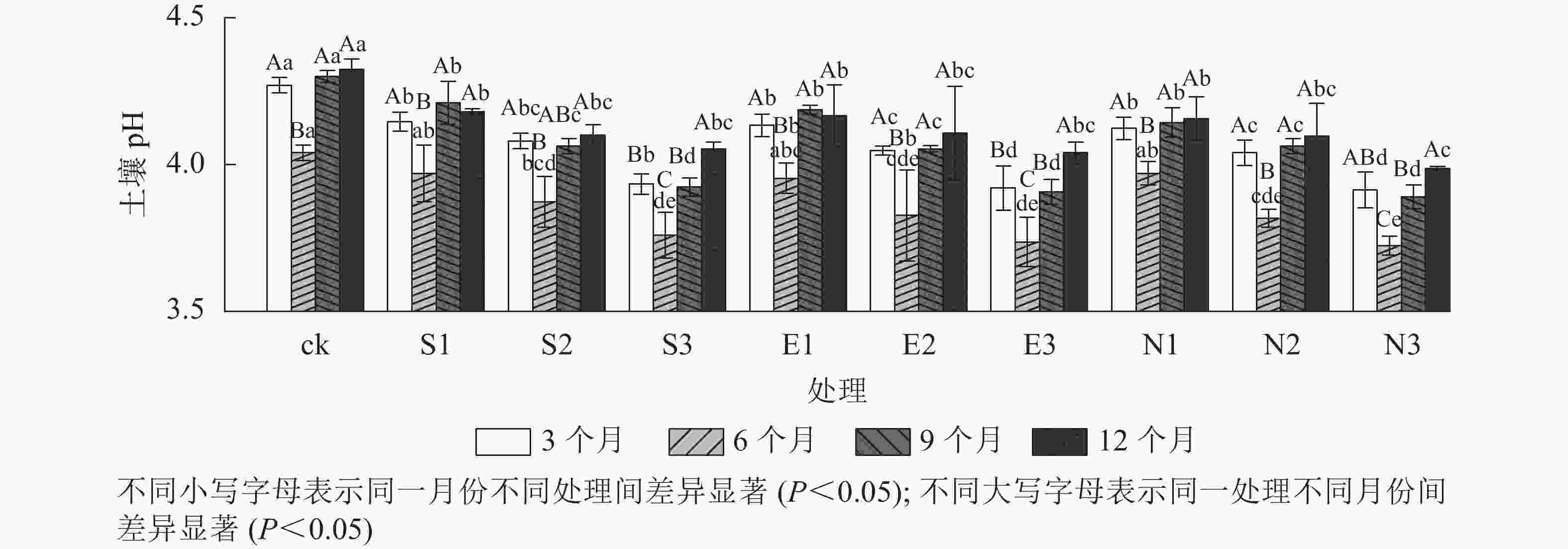


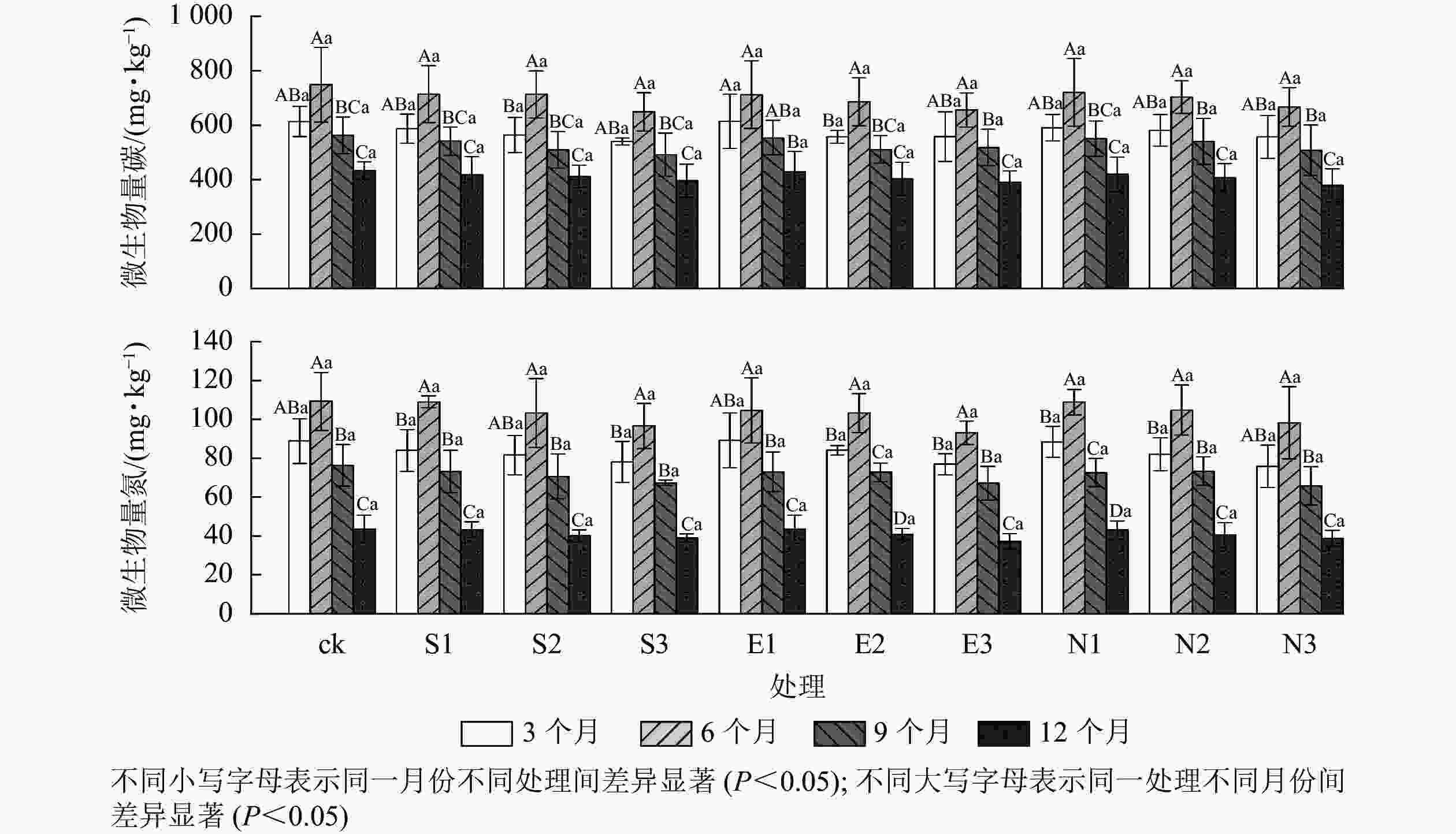
 DownLoad:
DownLoad:
